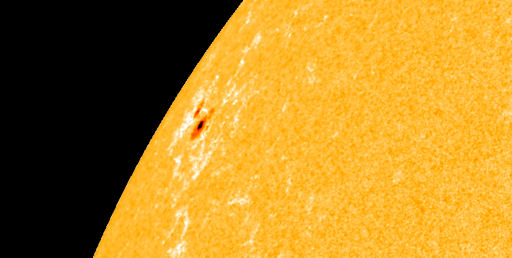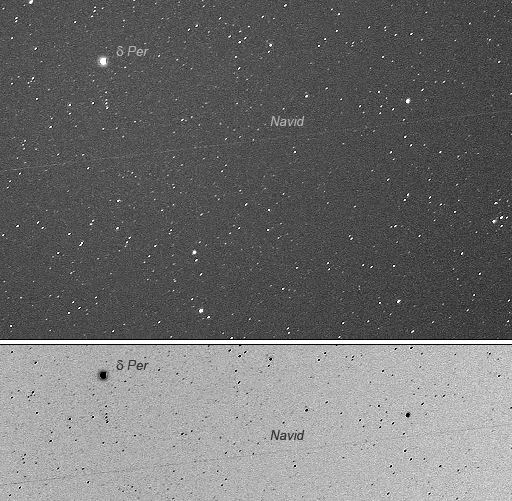CHANCE OF AURORAS: NOAA forecasters estimate a 30% of minor geomagnetic storms on Feb. 13-14 in response to the possible arrrival of a CME that left the sun on Feb. 10th. High-latitude sky watchers should be alert for auroras. Storm alerts: text, voice.
OLD SUNSPOT RETURNS: Sunspot AR1402, which unleashed an X2-class solar flare on Jan. 27th, has returned after a two-week transit around the far side of the sun. Two weeks of decay have greatly reduced the old active region:
The sunspot group, re-numbered AR1419 for its second apparition, is crackling with B- and C-class solar flares. These flares are minor compared to the eruptions of January. The return of AR1402 is mainly significant for nostalgic reasons .
IRANIAN SATELLITE: On Feb. 3rd, Iran launched the country's third satellite. Named "Navid," the 110-pound mini-spacecraft is meant to stay in orbit for 18 months, sending back images to Iran as it completes a revolution of Earth every 90 minutes. On Feb. 10th, veteran satellite observer Marco Langbroek photographed Navid as it passed over his home in Leiden, the Netherlands:
"It was a clear evening and I had a 71 degree elevation pass of Navid, which moves in a 250 x 375 km orbit," says Langbroek. "The satellite was invisible to the naked eye (I estimate its magnitude as +7), but my camera was able to record its faint trail moving just south of the alpha Persei star association. Measuring only 50 x 60 cm, Navid is the smallest object in orbit I have ever photographed."
Readers, although you can't see Navid, you can find out when it is flying overhead and possibly photograph it as Langbroek did. Local flyby times are available from SpaceWeather's Simple Satellite Tracker and Flybys App.

![]()
Solar wind
speed: 418.7 km/sec
density: 1.9 protons/cm3
explanation | more data
Updated: Today at 1524 UT
![]()
X-ray Solar Flares
6-hr max: B3 1443 UT Feb13
24-hr: B3 0022 UT Feb13
explanation | more data
Updated: Today at: 1500 UT
![]()
![]()
![]()
Daily Sun: 13 Feb 12
![]()
![]()
The remains of old sunspot 1402, which unleashed an X2-class solar flare on Jan. 27th, have returned in the form of sunspot 1419. Credit: SDO/HMI
![]()
![]()
![]()
Sunspot number: 80
What is the sunspot number?
Updated 12 Feb 2012
Spotless Days
Current Stretch: 0 days
2012 total: 0 days (0%)
2011 total: 2 days (<1%)
2010 total: 51 days (14%)
2009 total: 260 days (71%)
Since 2004: 821 days
Typical Solar Min: 486 days
Updated 12 Feb 2012
The Radio Sun
10.7 cm flux: 110 sfu
explanation | more data
Updated 12 Feb 2012
![]()
![]()
![]()
Current Auroral Oval:
Switch to: Europe, USA, New Zealand, Antarctica
Credit: NOAA/POES
![]()
![]()
![]()
Planetary K-index
Now: Kp= 3 quiet
24-hr max: Kp= 3 quiet
explanation | more data
![]()
Interplanetary Mag. Field
Btotal: 10.3 nT
Bz: 3.1 nT south
explanation | more data
Updated: Today at 1527 UT
![]()
![]()
![]()
Coronal Holes: 13 Feb 12
![]()
![]()
Solar wind flowing from this coronal hole could reach Earth on Feb. 16-17. Credit: SDO/AIA.
![]()
![]()
![]() SPACE WEATHER
SPACE WEATHER
NOAA Forecasts

![]()
![]()
Updated at: 2012 Feb 12 2200 UTC
![]()
![]()
![]()
![]()
Geomagnetic Storms:
Probabilities for significant disturbances in Earth's magnetic field are given for three activity levels: active, minor storm, severe storm
![]()
Updated at: 2012 Feb 12 2200 UTC
![]()
Mid-latitudes
![]()
High latitudes






